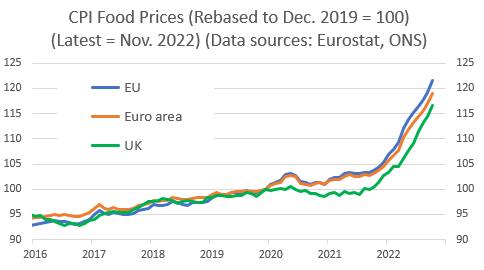Post by Dan Dare on Jan 3, 2024 13:11:02 GMT
Not much interest in the global situation it seems, perhaps like the government people here are confident in the ability of the markets to cure all ills and don’t wish the post-holiday torpor to be disrupted by dissenting voices. Perhaps a discussion of the UK-specific context might stir more debate, so here goes:
Theme 2: UK Food Supply Sources
The report is quite bullish about the UK’s present food supply security. It notes that:
“…The UK currently produces about 60% of its domestic food consumption by economic value, part of which is exported. This means just under half of the actual food on plates is produced in the UK, including the majority of grains, meat, dairy, and eggs. This figure would be higher without exports. UK supply comprises domestic production excluding exports, plus imported food. The production to supply ratio, important for understanding the UK’s self-sufficiency, has remained stable over the last two decades, and for crops that can be commercially grown in the UK has been around 75%.”
It mentions that the self-sufficiency ratio has remained stable for two decades, which must mean that agricultural productivity has improved sufficiently to counter both the increase in population and reduction in farmland over that period. The population of the UK increased by 8 million (14%) over the period, an annual rate of slightly more than 0.6%. If the same rate of increase is sustained – and there is nothing to indicate it will not – the population will reach 80 million by 2050. To maintain present levels of self-sufficiency given that degree of change is likely to prove highly challenging, but Defra turns a blind eye to that complicating factor, just as it did at the global level, opting to ignore any future effects of population change beyond 2030.
But first, let’s consider what Defra has to say about productive agricultural land in the UK. It estimates that 71% of the UK land area, or 17.3 million hectares, is used for agricultural purposes. Of this, 72% is grassland and 26% cropland, with the remainder being set-aside or fallow land. The latter has declined considerably since the early 2000s so it can be said that agricultural land in the UK is close to being completely used. Defra notes its concerns about long-term soil health in the UK, which it says "...is perhaps the single most important factor for future domestic food production." It says that intensive farming practices are a key contributor to deteriorating soil health and that "Estimates suggest soil degradation, erosion, and compaction result in losses of about £1.2 billion each year and reduce the capacity of UK soils to produce food."
I’ll leave it there for now and return later.
Theme 2: UK Food Supply Sources
The report is quite bullish about the UK’s present food supply security. It notes that:
“…The UK currently produces about 60% of its domestic food consumption by economic value, part of which is exported. This means just under half of the actual food on plates is produced in the UK, including the majority of grains, meat, dairy, and eggs. This figure would be higher without exports. UK supply comprises domestic production excluding exports, plus imported food. The production to supply ratio, important for understanding the UK’s self-sufficiency, has remained stable over the last two decades, and for crops that can be commercially grown in the UK has been around 75%.”
It mentions that the self-sufficiency ratio has remained stable for two decades, which must mean that agricultural productivity has improved sufficiently to counter both the increase in population and reduction in farmland over that period. The population of the UK increased by 8 million (14%) over the period, an annual rate of slightly more than 0.6%. If the same rate of increase is sustained – and there is nothing to indicate it will not – the population will reach 80 million by 2050. To maintain present levels of self-sufficiency given that degree of change is likely to prove highly challenging, but Defra turns a blind eye to that complicating factor, just as it did at the global level, opting to ignore any future effects of population change beyond 2030.
But first, let’s consider what Defra has to say about productive agricultural land in the UK. It estimates that 71% of the UK land area, or 17.3 million hectares, is used for agricultural purposes. Of this, 72% is grassland and 26% cropland, with the remainder being set-aside or fallow land. The latter has declined considerably since the early 2000s so it can be said that agricultural land in the UK is close to being completely used. Defra notes its concerns about long-term soil health in the UK, which it says "...is perhaps the single most important factor for future domestic food production." It says that intensive farming practices are a key contributor to deteriorating soil health and that "Estimates suggest soil degradation, erosion, and compaction result in losses of about £1.2 billion each year and reduce the capacity of UK soils to produce food."
I’ll leave it there for now and return later.



